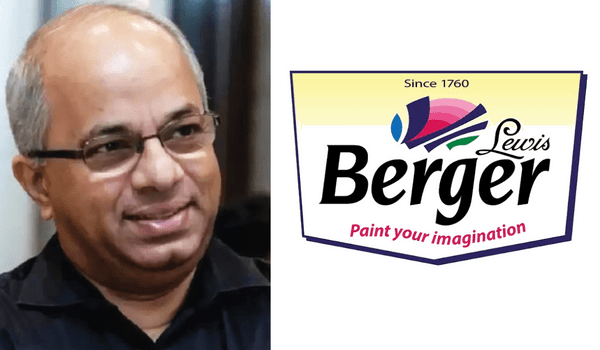Ranjan Banerjee, who has recently taken up the role of group HR head at Berger Paints, is an avid reader and is well regarded as an orator and a speaker. He loves spending his free time with his family and is in the habit of penning down his life experiences in a diary.
Though Banerjee loves writing, his tight schedule makes it difficult for him to take out time for this passion.
However, he is keen to resume this activity, which helps him formulate opinions and look back at his learnings.
Banerjee admits that a career in HR is not what he would have opted for, had he managed to clear his Indian civil services examination.
After graduating in political science, Banerjee prepared for the extremely tough and competitive UPSC examination, but failed to clear it. Realising how much of persistence was required to make the cut, Banerjee decided to drop the idea altogether.
From his early student days itself, Banerjee worshipped great leaders such as Indira Gandhi, Atal Bihari Vajpayee and PV Narasimha Rao, who were all known for their firm political stance and for bringing about significant change in the country’s politics and in India as a nation.
Science and maths never really interested Banerjee, but he was very passionate about understanding people, culture and history, which “made me think that in the corporate world, HR may be an area where I could add value”. Moreover, he had heard about professionals in his family talking about people related problems and their impact on the business. That is how Banerjee came to choose HR as a career. Regarded as a great orator and an excellent debater since childhood, leadership came naturally to Banerjee. “My peers, friends and teachers always praised me for my leadership qualities and some even looked up to me for the same,” says Banerjee.
Banerjee has managed to establish himself as an HR leader and professional who takes a stand in favour of change — a change for the better.
Talking of companies that advocate positive change, Banerjee cites the examples of Bata and Grasim, where there were several issues related to productivity, values and the manner of working when he joined these companies as an HR professional.
Although, he admits to facing resistance from many quarters — including the workers, union leaders and at times, even the management — his belief in making the right calls that could bring about a positive change in the organisational culture stood him in good stead.
It was rather early on in his career that Banerjee joined Bata India’s HR team. It was a time when the Company was going through volatile IR issues. “There were instances of ‘gherao’ and even a managing director of a plant being assaulted at the factory premises,” recalls Banerjee.
“It was a question of values, and as HR professionals, we took a stand and made some tough calls, which were required for the good of the business and our people culture,’ explains Banerjee. One of the toughest calls he had to take as an HR was when he had to terminate prominent union leaders from the factory at Bata. “There were strong repercussions and resistance from the workers, but we prepared ourselves for it,” Banerjee reveals.
Banerjee describes how they took all the stakeholders into confidence, including the management, some key government officials and the media, to overcome the workers’ resistance.
At Grasim too, Banerjee recalls having to deal with many problems, related to values and productivity, which had existed for over 70 years.
The HR leaders took the necessary hard calls, which did create tensions in the factories initially, but eventually everything settled down.
When Banerjee joined Vodafone as AVP-HR, the Company was going through a major transition due to the integration of Vodafone and Hutch.
Banerjee was involved in bringing about a massive change in terms of establishing the DE&I strategy at the Company. Given the large workforce
and the multinational environment, there were major complexities, and it was definitely a challenging task admits Banerjee.
Repercussions are bound to follow when one brings about change.
Without disclosing the name of the organisation, Banerjee describes an incident where some workers and union leaders stopped him from entering the factory. They were joined by many external elements and soon he found himself in the midst of a mob. “They tried to overturn my car and set it ablaze,” recalls Banerjee. He could have reversed his car and returned home, but “since I was the HR leader and the catalyst to the change which had pissed off the workers, I wanted to stand by it and face the mob, instead of running away,” asserts Banerjee.
Banerjee started clicking pictures of the mobsters and sent it to his colleagues, which scared the workers a bit. Also, the security guards helped Banerjee drive safely into the factory premises. Banerjee realised that he had been targeted only because people knew him as the “guy who had tried to bring about a change”.
Having got the opportunity to work for different sectors such as manufacturing, textiles, power, services and entertainment, Banerjee acquired the skill of adaptability. Banerjee believes that even though businesses may change and the background of workers may change, the formula of bringing about change in any company will remain the same.
There are four steps to bringing about change. “First is to identify the purpose of change. Second is to arrange for reinforcement systems to maintain that change.
“If you want to be the ‘good guy’ always, HR is not for you. You’d rather start selling Ice-Creams and make everyone feel happy”
Ranjan Banerjee, group head – HR, Berger Paints
Third is to develop the capability in people to adapt to that change, and fourth is to prepare role models for a particular change behaviour,” explains Banerjee.
Banerjee has trained in and grappled with IR quite early on in his career.
Immediately after postgraduating in IR, he got the opportunity to work with Aditya Birla Cements where the HR was just being set up. People such as TV Rao and Uday Parekh, were advising the Company in the process.
Banerjee was part of that team as a management trainee. After Aditya Birla Cements, he moved to Park Hotel for a while and then to United Breweries before joining Bata India, where he managed 9,000 workers and dealt with IR challenges head on. Banerjee benefitted from all the early exposure to IR as it prepared him for the bigger IR challenges that he faced later.
Banerjee makes a special mention of Samarjeet Chakrawarty and Sujeet Sain, his seniors at Bata India, who helped him understand and deal with various IR issues.
A major turning point in his life was his HR executive training at ITC, in 2005. He was amongst the critical talent picked by ITC every year to attend the executive training at Michigan University. Having been mentored by Dave Ulrich, he was able to understand the synergy between HR and the business.
“The experience really opened up new perspectives and changed my entire outlook towards HR,” admits Banerjee. Even after moving on from ITC, the learning from the executive course helped Banerjee in his various stints, such as the one at Saregama India, where the workforce was totally different, or the challenging one at Vodafone.
Banerjee’s schooling also made a difference. He studied at a boarding school, the T&N Academy in Gangtok. The discipline and holistic development approach there helped him develop his skills in areas beyond just academics.
He advises budding HR professionals who aspire to become leaders, to first master the art of time and work management, follow a healthy routine and develop the guts to take tough calls for the larger good.
“If you want to be the ‘good guy’ always, HR is not for you. You’d rather start selling ice-creams and make everyone feel happy. When you are in HR, you have to take tough calls, make the right decisions and stand by them till the end,” concludes Banerjee.
This article first appeared in the HRKatha Magazine
Value our content... contribute towards our growth. Even a small contribution a month would be of great help for us.
Since eight years, we have been serving the industry through daily news and stories. Our content is free for all and we plan to keep it that way.
Support HRKatha. Pay Here (All it takes is a minute)




































